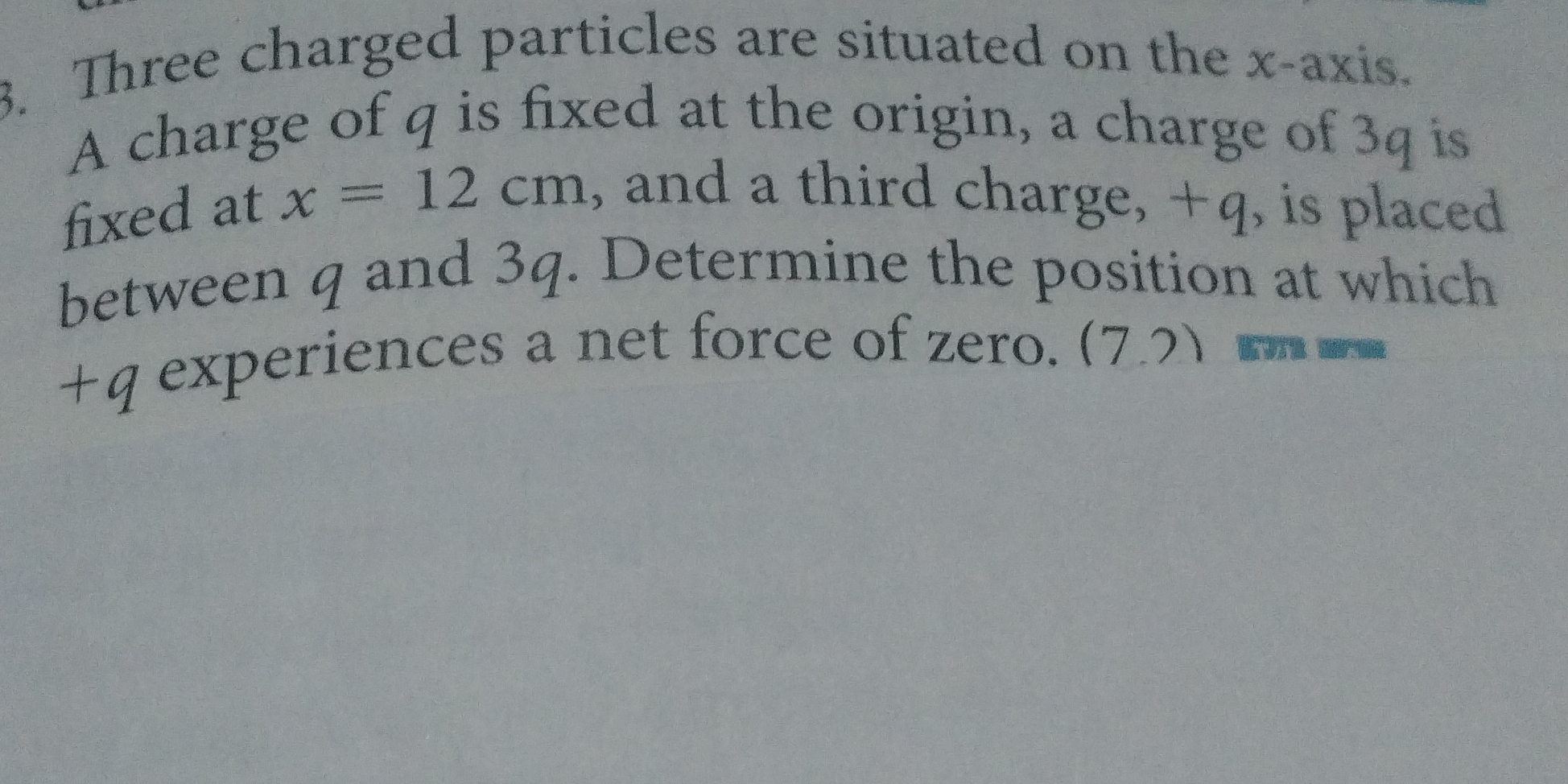Three charged particles are situated on the x-axis. A charge of q is fixed at the origin, a charge of 3q is fixed at x = 12 cm, and a third charge, +q, is placed between q and 3q.... Three charged particles are situated on the x-axis. A charge of q is fixed at the origin, a charge of 3q is fixed at x = 12 cm, and a third charge, +q, is placed between q and 3q. Determine the position at which +q experiences a net force of zero.

Understand the Problem
The question asks to determine the position on the x-axis where a charge of +q experiences a net force of zero due to the other two charges (q and 3q) that are fixed at specific positions. This involves applying Coulomb's law to find the point where the forces exerted by the two charges cancel each other out.
Answer
The position is approximately $d \approx 4.39$ cm.
Answer for screen readers
The position at which charge $+q$ experiences a net force of zero is approximately $d \approx 4.39$ cm.
Steps to Solve
-
Understanding Charge Positions
The charges are positioned as follows:
- Charge $q$ at the origin (position $x = 0$ cm)
- Charge $3q$ at position $x = 12$ cm
- Charge $+q$ is placed at position $x = d$ cm, where $0 < d < 12$
-
Apply Coulomb's Law
The force between two point charges is given by Coulomb's law: $$ F = k \frac{|q_1 q_2|}{r^2} $$ Where:
- $F$ is the force between the charges
- $k$ is Coulomb's constant
- $q_1$ and $q_2$ are the magnitudes of the charges
- $r$ is the distance between the charges
-
Calculate Forces Acting on +q
The forces acting on charge $+q$ due to the other two charges are:
- Force due to charge $q$: $$ F_{q \to +q} = k \frac{q \cdot q}{(d - 0)^2} = k \frac{q^2}{d^2} $$
- Force due to charge $3q$: $$ F_{3q \to +q} = k \frac{3q \cdot q}{(12 - d)^2} = k \frac{3q^2}{(12 - d)^2} $$
-
Set Forces Equal for Net Force of Zero
For the net force on charge $+q$ to be zero, the magnitudes of the forces must be equal: $$ F_{q \to +q} = F_{3q \to +q} $$ This gives us the equation: $$ k \frac{q^2}{d^2} = k \frac{3q^2}{(12 - d)^2} $$
-
Solve for d
Dividing both sides by $kq^2$ (which is non-zero), we have: $$ \frac{1}{d^2} = \frac{3}{(12 - d)^2} $$ Cross-multiplying gives: $$ (12 - d)^2 = 3d^2 $$ Expanding and rearranging gives: $$ 144 - 24d + d^2 = 3d^2 $$ $$ 2d^2 + 24d - 144 = 0 $$ Dividing through by 2: $$ d^2 + 12d - 72 = 0 $$
-
Apply the Quadratic Formula
To find the values of $d$, we can use the quadratic formula: $$ d = \frac{-b \pm \sqrt{b^2 - 4ac}}{2a} $$ Where $a = 1$, $b = 12$, and $c = -72$: $$ d = \frac{-12 \pm \sqrt{12^2 - 4 \cdot 1 \cdot (-72)}}{2 \cdot 1} $$ Simplifying: $$ d = \frac{-12 \pm \sqrt{144 + 288}}{2} $$ $$ d = \frac{-12 \pm \sqrt{432}}{2} $$ $$ \sqrt{432} = 12\sqrt{3} $$ Thus: $$ d = \frac{-12 \pm 12\sqrt{3}}{2} $$ Simplifying further: $$ d = -6 \pm 6\sqrt{3} $$
We discard the negative solution since $d$ must be positive: $$ d = -6 + 6\sqrt{3} $$
-
Calculate the Numerical Value of d
Estimating $d$ using $\sqrt{3} \approx 1.732$: $$ d \approx -6 + 10.392 \approx 4.392 \text{ cm} $$
The position at which charge $+q$ experiences a net force of zero is approximately $d \approx 4.39$ cm.
More Information
In this problem, we determined the position on the x-axis where a charge experiences a net force of zero due to two other fixed charges. This involves the application of Coulomb's Law and solving a quadratic equation, highlighting the relationships between electric forces and charge positions.
Tips
- Misapplying Coulomb's law by not using the correct distances for forces acting on $+q$.
- Forgetting to evaluate both solutions of the quadratic equation and discarding the negative one without justification.
AI-generated content may contain errors. Please verify critical information